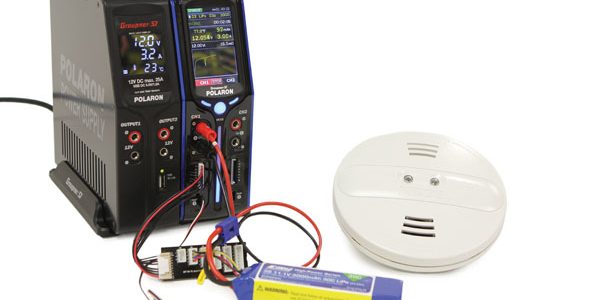What C-rating means and why it’s important
Most rotordrones and quadcopters we’ll ever encounter will be powered by batteries, and more specifically, Lithium Polymer (LiPo) battery packs. It is always important to follow the manufacturer’s recommendations for charging. One question that is often asked is: “What is a battery’s C-rating?” The short answer is that when it comes to flight times and motor performance, the higher a battery’s C-rating, the more likely it will make you smile. A 45C pack makes a joke of a 10C pack when it comes to power delivery.

Regardless of your battery pack’s C-rating, job one is to safely charge your batteries. Ideally, you don’t want to be in a hurry, so use a 1C charge rate.
DEFINITION
Quite simply, a C-rating on a LiPo battery refers to its capacity of energy it can safely discharge, represented as a multiple of its overall capacity. A higher C-rated battery delivers more energy, and that means higher performance. The big difference between batteries with different C-ratings is the fact that the higher-rated batteries suffer less from voltage drops under load. This ability to maintain a higher and more consistent voltage is what typically generates the high performance we enjoy. This is particularly important when you have multiple motors turning multiple rotors.

Where voltage refers to your battery’s horsepower, the capacity of the pack refers to how big your fuel tank is. The bigger the capacity, the longer you will be able to fly your quadcopter.
BY THE NUMBERS
As an example, a lower rated 10C battery will deliver 10 times its own capacity. A 2000mAh pack will safely deliver 20 amps continuously (10 times 2000mAh equals 20 amps). A 20C pack of the same capacity will safely allow you to draw 40 amps from it continuously. That’s the same capacity and twice the amp draw. There are battery packs out there rated at 30C, 45C, and even 70C that will deliver (in our 2000mAh example) 60, 90 and 140 amps. This major increase in current allows us to run bigger (or more) motors in your multirotor for increased duration and/or payload lifting capabilities. A higher C discharge rating gives us that extra “oomph” we enjoy in flight, no matter the airframe.

When it comes to actually knowing what’s going on with your battery pack and your power system, the best thing you can do is to use a power-meter hooked up between your quadcopter and the battery pack.
WHAT’S CAPACITY
The output capacity of a battery pack is referred to in milliamps per hour (mAh). This is the amount of current you can expect to pull from your packs during normal operation. Where voltage of a pack (V) can be thought of as the amount of power and performance available, think of mAh as how much flight time you can draw from the pack. It’s like the size of your quadcopter’s “gas tank.” A smaller battery, like a 2400mAh pack, will provide a shorter flight time than a larger pack, such as a 4200mAh pack.

There’s a lot of energy contained in a LiPo battery pack, and one way to keep track of its condition while being charged is to use a temperature probe. This will sound an alarm if the pack gets too hot.

While charging, use a fireproof charging sack (shown here) or a metal container to minimize the amount of air and lessen the chance of a fire starting.
CHARGING AND SAFETY
Always use a “LiPo sack” or other safe charging battery container while charging your packs. Surplus military ammo cans available at Army/Navy outlet stores make great battery storage containers.
Use a high-quality charger for consistent results. I prefer charging systems with built-in balance ports and I recommend that you balance-charge your packs regardless of their charge/discharge rating. Balance-charging will keep the individual cells in each pack the same voltage for maximum efficiency and to extend the life of your pack. There are also balance bridges or balance port extensions that allow for several cell counts and the different types of plugs used with many battery packs.
Although a higher C-rated pack can often be charged in less time as they can tolerate a higher current rate, don’t be in a rush; you can always charge them at 1C (one times the capacity), which will take about an hour for a complete charge. Doing this has produced the best results in my experience; I have some older packs that still operate well after hundreds of charge and discharge cycles. Recently, for an added bit of safety, I’ve started to use a battery-powered smoke detector close to my charging station in addition to my temperature-monitoring probe. As a final safety requirement, never leave a charging battery pack unattended. Stay in the vicinity so you can monitor the condition of your battery while it is being charged.
C-RATING AND MONITORING
So, how do we know whether or not a battery pack is true to its labeled rating? And how does a battery manufacturer measure and arrive at a C-rating number? Packs have quite a range of quoted discharge rates; once used, however, we may find that the pack’s indicated C-rating has more to do with marketing than actual performance. Here, it is buyer beware! Check out what other people are using and stick with quality brands for your battery. If you’re tempted to use a really inexpensive battery, first think of how much your rotordrone is worth. After all, your battery pack is the heart of your aircraft!
By Mike Gantt | Photos by John Reid



















